Earth's Rotation
Revolution and Rotation Worksheet
Contrast Earth's rotation and revolution using the Astronomy Unit Study MatchCard.
Free Download Below
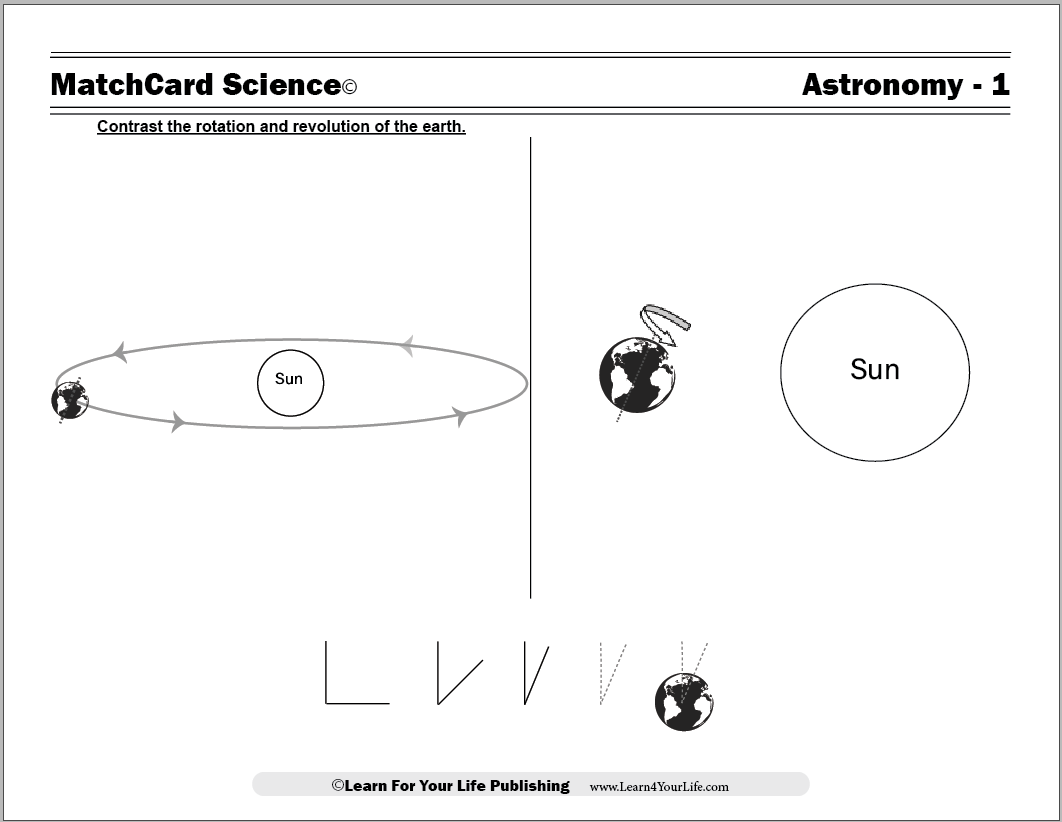
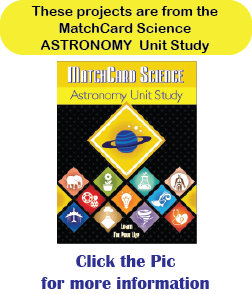
Rotation and Revolution MatchCard
Objective: Contrast the Earth's rotation and revolution and the effect of each.MatchCard: Download below.
MatchCard Information Pieces identify diagrams of revolution and rotation and the impact on the planet. Ideas for projects are listed on the instructor's page and below.
Download and Use the Earth's Rotation and Revolution MatchCard
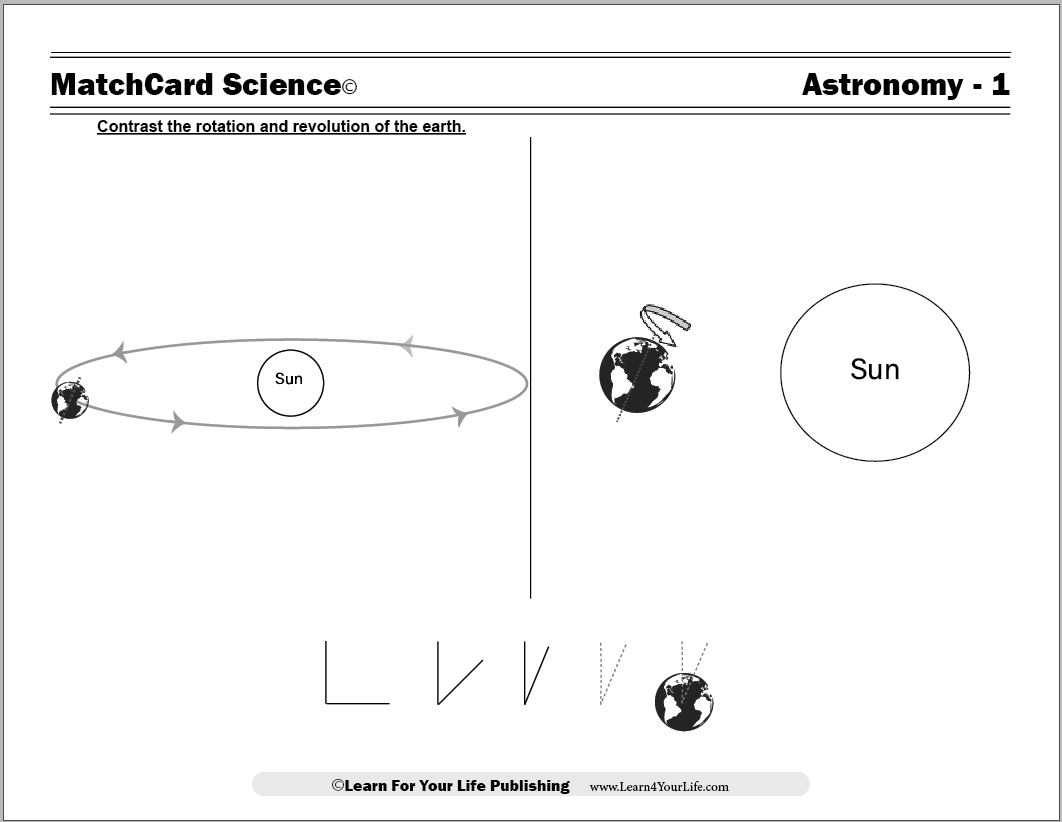

Click image to go to download.
This is MatchCard #1 of the Astronomy Unit Study. Find more information on MatchCard Science below.
Demonstrate Earth's Revolution and Rotation
To some this demonstration seems so common place as to not be needed. However, even if you have done it before, it helps students to grasp the cause and effect of the Earth's rotation and revolution.You will need:
- Globe (or sphere) to represent the Earth
- Lamp or light source to represent the sun
- Miniature figure, sticker, or drawing to represent you
- Space to revolve around the sun
Watch the Earth's Rotation
While doing these demonstrations, tilt the Earth to give it approximately a 23 degree axis. (They will learn about that later in the Astrononmy Unit Study.)Rotate the globe on it's axis with the light source shining on it. Discuss when they have day and when they have night time.
Other facts to discuss:
- What country is completely opposite you on the globe
- Different time zones and why they are there
- The international date line
Watch the Earth's Revolution
Keeping the 23 degree tilt, walk so that the globe is circling the light source. If you are using a flashlight or light source that only shines in one direction, someone will have to rotate to keep the light source shining on the earth.Explain that revolving around the sun means making a circle around it. It takes one year - or approximately 365 1/4 days - for the Earth to revolve around the sun.
Ask the student to make the Earth revolve while continuing to rotate it on its axis. Consider the tiny steps one would have to make to rotate the Earth 365 times for each revolution around the sun.
Now stand still so that the tilt of the Earth is causing the North Pole to be closest to the sun. Ask the student if the North Pole would be experiencing summer or winter here. (Answer: summer) Now move to the opposite side of the globe and show how the Earth's axis tilts the North Pole away from the sun during winter. Other Facts to discuss:
- The different hemisphere's have summer and winter at different times of the year
- Alaska as the land of the midnight sun
- Why the equator is the hottest and the poles are the coldest locations on the planet
- The reason for leap year every four years.
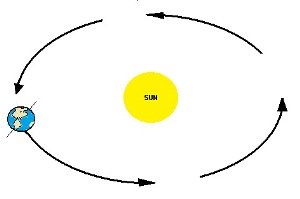
Make Your Own Sundial
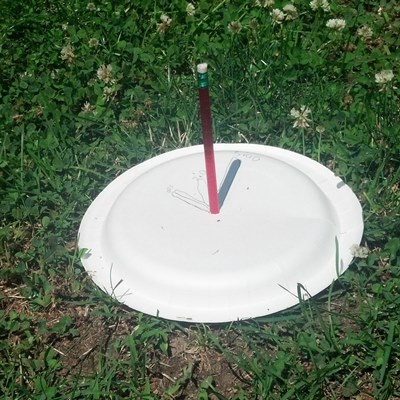 Another way to grasp the implication of the sun's rotation is with a simple sundial.
Another way to grasp the implication of the sun's rotation is with a simple sundial.You will need:
- Paper Plate
- Two sharpened pencils
- An area in a field or away from objects that cast shadows
Every hour, on the hour, they trace the shadow cast by the pencil onto the plate. They write the time at the end of the plate.
Ideally, this exercise should start at sunup and continue until sundown. It helps to set a timer so you don't miss the top of the hour.
As an alternative, you can use a pole like a mailbox pole. Place rocks with the time written on them at the top of the shadow each hour.
Students will note how the shadow changes with the direction of the sun's rays. They will also note how the shadow is shorter when the sun is high in the sky and longer when it is lower in the sky.
More Activities on Rotation and Revolution
Vocabulary
Some students easily understand the conceps of rotation and revolution, but get the terms mixed up.Think of the phrase: "He thinks the world revolves around him." Discuss the metaphor of someone thinking they are at the center of everything and others revolving around them.
You can also think of the "t" in rotation as the invisible axis the Earth rotates on.
Blindfolded Rotation
Blindfold the student, and spin him or her so they loose their sense of direction. Let them stand near the light source and rotate. Can they identify when they are facing the light and when they are away from it?They can also rotate themselves. Think of one foot as the “t” in rotation, they use their other foot to push themselves in a circle. Can they make a 360 degree circle with their eyes shut? Use a compass or protractor to measure how close they can come to a 360 degree rotation while blindfolded.
Dancer's Rotation and Revolution
Young dancers will enjoy this activity. Let them perform a dance that demonstrates the difference between rotation and revolution. Ballet dancers will particularly enjoy performing their spinning rotations. But less complicated dances such as square dance and folk dancing will have rotations and revolutions.Ice skating is another example which has a strong contrast between rotation and revolution. The rotation occurs when the skater spins in a small circle. Revolution occurs when he or she skates around the rink.
Clockwise and Counter Clockwise
Introduce young students to the concepts or clockwise and counter clockwise which will be used in the next activity. Use a clock face if necessary.The earth rotates and revolves in counter clockwise directions.
Mother May I (Spin)
Here’s a variation on the game Mother May I which practices the concepts of rotation, revolution, clockwise and counterclockwise.Tell the student to rotate (or revolve) clockwise (or counterclock wise.) They then proceed to carry out your command.
You can do this as a competition or until they demonstrate the know the difference.
How Much Is 23.44 Degrees

Take a sheet of paper with a ninety degree corner and fold it in half to make a 45 degree angle. Repeat the fold for a 22.5 degree angle. That is close to the 23.44 angle of the earth's axis.
If there was no angle, the equator and the axis would be perpindicular. The equator is now at a 23.44 degree to the axis.
MatchCard Science
How To Use MatchCards

Download the FREE MatchCard Science Instructor's Guide and see how MatchCards can make building their science knowledge base fun.
Astronomy Unit Study
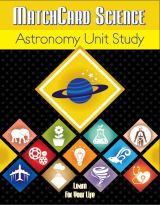
Explore the universe with the MatchCard Science Astronomy Unit Study..
12 Science Unit Studies

Chemistry is only one of twelve complete unit studies for kids in 3rd to 8th grade.
Comprehensive objectives, hands-on projects, suggested science fair experiments, and the fun game-like MatchCards keep them interested in learning science. See all twelve MatchCard Science Unit Studies.
About Our Site
Hands-On Learning













